RESULTS
Table 1
summarises the data on cheilostome and cyclostome generic diversity changes.
Standing diversities
Following the end-Palaeozoic extinction,
cyclostome bryozoans reappear in the fossil record by the Carnian Stage of the
Upper Triassic (Bizzarini and
Braga 1981). They diversified slowly through the Late Triassic and Early
Jurassic but more rapidly during the Mid Jurassic and Early Cretaceous.
Sixty-three genera are known from the latest Early Cretaceous (Albian), the
oldest stage included in this study.  During
the Late Cretaceous, cyclostomes steadily increased in diversity to the 170
genera known in Maastrichtian rocks (Figure
2). They declined drastically from the Maastrichtian to the Thanetian and
then remained at an approximately constant diversity level through the Cenozoic.
(Note that Figure 2 plots only fossil
diversity; Holocene data are not plotted.)
During
the Late Cretaceous, cyclostomes steadily increased in diversity to the 170
genera known in Maastrichtian rocks (Figure
2). They declined drastically from the Maastrichtian to the Thanetian and
then remained at an approximately constant diversity level through the Cenozoic.
(Note that Figure 2 plots only fossil
diversity; Holocene data are not plotted.)
Cheilostomes first appeared in the Late Jurassic (Taylor
1994) but diversified very slowly during the Early Cretaceous, with only 10
genera known from the Albian. During the Late Cretaceous, cheilostomes
diversified rapidly to reach a level of 185 known genera in the Maastrichtian (Figure
2). Subsequently, they declined through the Palaeocene to a Thanetian
diversity of 125 genera. After the Thanetian, they again diversified through
much of the remaining Cenozoic, interrupted by a modest Oligocene reversal,
apparently reaching a plateau of 240 to 250 genera during the Neogene.
Extinctions
 The
absolute number of extinctions for both clades is highest for the Maastrichtian
(Figure 3). Sixty-one cyclostome genera
that ranged through two or more stages have their last record in the
Maastrichtian, and 18 are known only from the Maastrichtian, making a total of
79 Maastrichtian cyclostome genera that did not survive beyond the K-T boundary.
Fifty-five long-ranged cheilostome genera have their last record in the
Maastrichtian, and 26 are known only from that stage, totalling 81 Maastrichtian
cheilostomes that did not cross the K-T boundary.
The
absolute number of extinctions for both clades is highest for the Maastrichtian
(Figure 3). Sixty-one cyclostome genera
that ranged through two or more stages have their last record in the
Maastrichtian, and 18 are known only from the Maastrichtian, making a total of
79 Maastrichtian cyclostome genera that did not survive beyond the K-T boundary.
Fifty-five long-ranged cheilostome genera have their last record in the
Maastrichtian, and 26 are known only from that stage, totalling 81 Maastrichtian
cheilostomes that did not cross the K-T boundary. 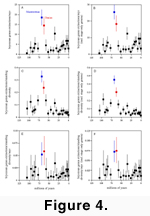 The
second-highest number of extinctions occurred during the Danian for both clades:
26 long-ranged plus 3 stage-only cyclostomes, and 33 long-ranged plus 13
stage-only cheilostomes became extinct in the Danian. These Maastrichtian and
Danian extinctions are much higher than extinctions in any other Late Cretaceous
or Cenozoic stage. The next highest number of extinctions for cyclostome genera
occurred during the Campanian (14 long-ranged plus 3 stage-only), and for
cheilostomes during the Priabonian (24 long-ranged plus 4 stage-only).
The
second-highest number of extinctions occurred during the Danian for both clades:
26 long-ranged plus 3 stage-only cyclostomes, and 33 long-ranged plus 13
stage-only cheilostomes became extinct in the Danian. These Maastrichtian and
Danian extinctions are much higher than extinctions in any other Late Cretaceous
or Cenozoic stage. The next highest number of extinctions for cyclostome genera
occurred during the Campanian (14 long-ranged plus 3 stage-only), and for
cheilostomes during the Priabonian (24 long-ranged plus 4 stage-only).
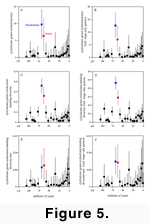 Extinctions
per million years (E/myr) were also high during the Maastrichtian and Danian
both when the two clades are considered together (Figure
4A, B) and individually (Figure 5A, B;
Figure 6A, B). Based on genera not
confined to a single stage, cyclostomes extinction rates were 9.7 genera/myr in
the Maastrichtian, and 6.3 genera/myr in the Danian; cheilostomes extinction
rate were 8.7 genera/ myr in the Maastrichtian, and 8.0 genera/myr in the Danian.
Including stage-only genera, cyclostome extinction rates were 12.5 genera/myr
and 7.1 genera/myr and cheilostome rates were 9 genera/myr and 11.2 genera/myr,
respectively.
Extinctions
per million years (E/myr) were also high during the Maastrichtian and Danian
both when the two clades are considered together (Figure
4A, B) and individually (Figure 5A, B;
Figure 6A, B). Based on genera not
confined to a single stage, cyclostomes extinction rates were 9.7 genera/myr in
the Maastrichtian, and 6.3 genera/myr in the Danian; cheilostomes extinction
rate were 8.7 genera/ myr in the Maastrichtian, and 8.0 genera/myr in the Danian.
Including stage-only genera, cyclostome extinction rates were 12.5 genera/myr
and 7.1 genera/myr and cheilostome rates were 9 genera/myr and 11.2 genera/myr,
respectively. 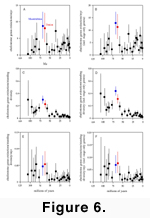 As
with absolute numbers of extinctions, these rate values are well above
background levels (Figure 7A, B). The
next highest rates for cyclostomes are 3.3 genera/myr and 4.4 genera/myr
(including stage-only genera) in the Piacenzian, and for cheilostomes 7.3
genera/myr and 8.5 genera/myr (including stage-only genera) in the Priabonian.
As
with absolute numbers of extinctions, these rate values are well above
background levels (Figure 7A, B). The
next highest rates for cyclostomes are 3.3 genera/myr and 4.4 genera/myr
(including stage-only genera) in the Piacenzian, and for cheilostomes 7.3
genera/myr and 8.5 genera/myr (including stage-only genera) in the Priabonian.
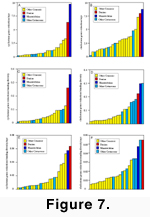 Number
of extinctions per standing diversity (E/D) also peaked during the Maastrichtian
and Danian (Figure 4C, D; Figure
5C, D; Figure 6C, D). Cyclostome
extinctions were 0.38 genera/D (0.46 genera/D including stage-only) for the
Maastrichtian, and 0.26 genera/D (0.36 genera/D including stage-only) for the
Danian. Values for cheilostomes are 0.30 genera/D (0.44 genera/D including
stage-only) for the Maastrichtian, and 0.22 genera/D (0.33 genera/D including
stage-only) for the Danian. Again, these are well above background levels (Figure
7C, D). Next highest values for cyclostomes are 0.13 genera/D (0.16 genera/D
including stage-only) for the Priabonian, and for cheilostomes 0.17 genera/D
(0.21 genera/D including stage-only) for the Campanian.
Number
of extinctions per standing diversity (E/D) also peaked during the Maastrichtian
and Danian (Figure 4C, D; Figure
5C, D; Figure 6C, D). Cyclostome
extinctions were 0.38 genera/D (0.46 genera/D including stage-only) for the
Maastrichtian, and 0.26 genera/D (0.36 genera/D including stage-only) for the
Danian. Values for cheilostomes are 0.30 genera/D (0.44 genera/D including
stage-only) for the Maastrichtian, and 0.22 genera/D (0.33 genera/D including
stage-only) for the Danian. Again, these are well above background levels (Figure
7C, D). Next highest values for cyclostomes are 0.13 genera/D (0.16 genera/D
including stage-only) for the Priabonian, and for cheilostomes 0.17 genera/D
(0.21 genera/D including stage-only) for the Campanian.
Finally, calibrating extinctions by both standing
diversity and time (E/D/myr), Maastrichtian and Danian extinctions still stand
above background levels (Figure 4E, F; Figure
5E, F; Figure 6E, F). Cyclostome
extinctions were 0.06 genera/D/myr (0.07 genera/D/myr including stage-only) for
the Maastrichtian, with the same values for the Danian. Values for cheilostomes
are 0.05 genera/D/myr (0.07 genera/D/myr including stage-only) for the
Maastrichtian, and 0.05 genera/D/myr (0.08 genera/D/ myr including stage-only)
for the Danian. While Maastrichtian and Danian extinctions per standing
diversity per million years stand well above background level (Figure
7E, F), they are essentially matched in the Piacenzian for cyclostomes (0.05
genera/D/myr, and 0.07 genera/D/myr including stage-only), and in the Santonian
for cheilostomes (0.05 genera/ D/myr and 0.07 genera/D/myr including
stage-only).
Originations
 The
absolute number of originations for both clades is highest for the Maastrichtian
(Figure 8). Thirty-four cyclostome
genera that ranged through two or more stages have their first record in the
Maastrichtian. Adding the 18 that are known only from the Maastrichtian brings
the total to 52 Maastrichtian cyclostome originations. Sixty long-ranged
cheilostome genera have their first record in the Maastrichtian. Adding the 26
that are known only from that stage brings total Maastrichtian cheilostome
originations to 86. The second-highest number of cyclostome originations was
during the Cenomanian when 28 long-ranged and six stage-only (making 34 in
total) cyclostome genera appeared.
The
absolute number of originations for both clades is highest for the Maastrichtian
(Figure 8). Thirty-four cyclostome
genera that ranged through two or more stages have their first record in the
Maastrichtian. Adding the 18 that are known only from the Maastrichtian brings
the total to 52 Maastrichtian cyclostome originations. Sixty long-ranged
cheilostome genera have their first record in the Maastrichtian. Adding the 26
that are known only from that stage brings total Maastrichtian cheilostome
originations to 86. The second-highest number of cyclostome originations was
during the Cenomanian when 28 long-ranged and six stage-only (making 34 in
total) cyclostome genera appeared. 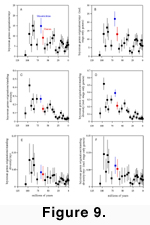 The
second-highest number of cheilostome originations is found in the Lutetian,
which has the earliest records of 49 long-ranged and 8 stage-only genera (57
total).
The
second-highest number of cheilostome originations is found in the Lutetian,
which has the earliest records of 49 long-ranged and 8 stage-only genera (57
total).
Originations per million years (O/Ma) were also
high near the transition from Cretaceous to Cenozoic (Figure
9A, B; Figure 10A, B; Figure
11A, B). Maastrichtian cyclostome originations were 5.4 genera/myr for
long-ranged genera and 8.3 genera/myr including stage-only genera. 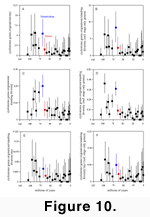 However,
cyclostome originations/myr were not above background levels during the Danian (Figure
12A). Instead, the Cenomanian had originations/myr almost equal to the
Maastrichtian (5.2 genera/myr without and 6.3 genera/myr with stage-only
genera). Cheilostome originations/myr were high during both stages: 9.5 genera/myr
without and 13.7 genera/myr including stage-only genera for the Maastrichtian,
and 7.6 genera/myr and 10.7 genera/myr, respectively, for the Danian. However,
these Maastrichtian and Danian values for cheilostome originations/myr scarcely
differ from those for the Coniacian, Santonian, Bartonian, and Priabonian (Figure
11A, B; Figure 12B).
However,
cyclostome originations/myr were not above background levels during the Danian (Figure
12A). Instead, the Cenomanian had originations/myr almost equal to the
Maastrichtian (5.2 genera/myr without and 6.3 genera/myr with stage-only
genera). Cheilostome originations/myr were high during both stages: 9.5 genera/myr
without and 13.7 genera/myr including stage-only genera for the Maastrichtian,
and 7.6 genera/myr and 10.7 genera/myr, respectively, for the Danian. However,
these Maastrichtian and Danian values for cheilostome originations/myr scarcely
differ from those for the Coniacian, Santonian, Bartonian, and Priabonian (Figure
11A, B; Figure 12B).
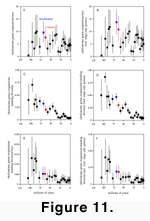 Number
of genera originating per standing diversity (O/D) was high for cyclostomes
during the Maastrichtian (0.20 genera/D for long-ranged and 0.33 genera/D
including stage-only genera), but these values are exceeded by those for the
Cenomanian (Figure 10C, D; Figure
12C) and are not much above those for the Coniacian and Campanian. The value
of O/D for the Danian is not above background levels. Cheilostome O/D for the
Maastrichtian (0.32 genera/D for long-ranged and 0.46 genera/D including
stage-only genera) are exceeded by or approximately equal all other Late
Cretaceous stages and were almost equalled by Lutetian O/D values.
Number
of genera originating per standing diversity (O/D) was high for cyclostomes
during the Maastrichtian (0.20 genera/D for long-ranged and 0.33 genera/D
including stage-only genera), but these values are exceeded by those for the
Cenomanian (Figure 10C, D; Figure
12C) and are not much above those for the Coniacian and Campanian. The value
of O/D for the Danian is not above background levels. Cheilostome O/D for the
Maastrichtian (0.32 genera/D for long-ranged and 0.46 genera/D including
stage-only genera) are exceeded by or approximately equal all other Late
Cretaceous stages and were almost equalled by Lutetian O/D values. 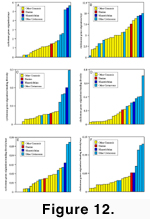 Danian
cheilostome generic O/D values are only slightly above the median value for all
stages (Figure 11C, D; Figure
12D).
Danian
cheilostome generic O/D values are only slightly above the median value for all
stages (Figure 11C, D; Figure
12D).
Originations calibrated by both standing diversity
and time (O/D/myr) for the Maastrichtian and Danian are even closer to the norm
for Late Cretaceous and Cenozoic stages (Figures
9E, F; Figure 10E, F; Figure
11 E, F; Figure 12E, F).
Maastrichtian cyclostome values (0.03 genera/D/myr for long-ranged genera and
0.05 genera/D/myr including stage-only) are far exceeded by Cenomanian and
Coniacian values, and the Danian values are near the median for all stages.
Cheilostome generic originations/D/myr for both Maastrichtian and Danian are
only slightly above typical values for the Cenozoic and are exceeded minimally
by Turonian and substantially by Cenomanian, Coniacian, and Santonian values;
i.e., Maastrichtian and Danian cheilostome O/ D/myr are below the norm of Late
Cretaceous stages but high relative to Cenozoic stages.

 During
the Late Cretaceous, cyclostomes steadily increased in diversity to the 170
genera known in Maastrichtian rocks (Figure
2). They declined drastically from the Maastrichtian to the Thanetian and
then remained at an approximately constant diversity level through the Cenozoic.
(Note that Figure 2 plots only fossil
diversity; Holocene data are not plotted.)
During
the Late Cretaceous, cyclostomes steadily increased in diversity to the 170
genera known in Maastrichtian rocks (Figure
2). They declined drastically from the Maastrichtian to the Thanetian and
then remained at an approximately constant diversity level through the Cenozoic.
(Note that Figure 2 plots only fossil
diversity; Holocene data are not plotted.)








